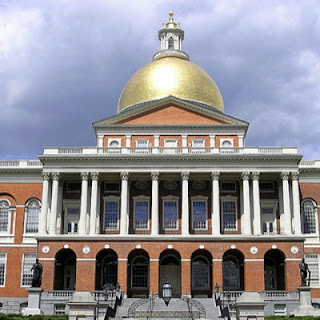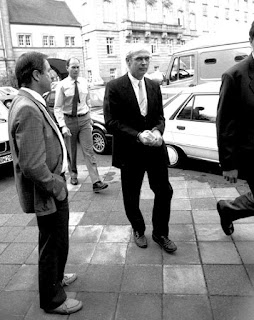The Sword AND The Stone (Part Seven)
Blog Table of Contents
“The latest, exhaustive phase in the inquiry is based on a tip that a caller made to authorities in 2010, according to Anthony Amore, the Gardner Museum’s head of security and chief investigator. He said Tuesday that the tip was so fruitful — leading to the announcement that investigators know the identities of the thieves.”
This story was couched in hazy enough language that Kowenhoven’s statement was not a total contradiction, for those trying their best to follow along. But it was interesting in that investigators were not claiming to have been pursuing a lead, a lead had found them and it had not only allowed them to identify the thieves, but pointed to the whereabouts of the paintings (or not as it turned out.)
But it did seem
to contradict statement made to the BBC’s Alastair Sooke for a BBC documentary
called “The
World's Most Expensive Stolen Paintings”
Sooke: The FBI now believes they knew who broke into the Gardner that night in 1990. But there are no immediate plans to arrest their suspects.
 |
| Statehouse Commonwealth of Massachusetts |
Looking at the Gardner Heist
investigation, from the standpoint of those most directly touched by it, in
nearly every instance, the investigation has either been openly criticized, or else
the first person accounts of people’s experiences with the authorities on
matters related to the case cast serious doubts about the quality of the
investigation. And not for the actions of investigators, but for their
inaction, along with their imposition of inaction upon others, such as the
museum and state and local law enforcement, who might otherwise have an interest
or some formal legal basis pursue it.
 |
| Former Gardner Museum Trustee Francis W. Hatch Jr. |
Gardner Heist investigation critics include:
The former head of the Gardner Museum Anne Hawley, a leading Gardner Museum trustee
and citizen of the Commonwealth, Francis Hatch, the Director at the Hyde
Collection, Frederick J. Fisher, the current security director, Anthony Amore,
(although what Amore said was not intended as criticism) and both of the authors
who have written well received nonfiction books about the case, Ulrich Boser
and Stephen Kurkjian.
 |
| Gardner Heist Author Ulrich Boser |
There is also a private security
systems consultant brought in by the Museum, Steve Keller who was very
critical based on his experience being interviewed, along with both eye witnesses who have spoken publicly about their experiences
with the investigation, Rick Abath and another witness who wished to remain
anonymous have criticized it.
Also, the
Governor of Massachusetts at the time of the robbery Michael Dukakis, and the
then mayor of Boston Raymond Flynn. Another critic is a former head of the
state police who was a lower ranking officer at the time of the Gardner Heist, Colonel
Thomas J. Foley. A member of the Gardner
Museum security team rank and file at the time of the robbery Marjorie Galas, and
the experiences of some uniformed members of the Boston Police also suggest a
less than thorough and determined effort to find out who was responsible, as has been chronicled by Stephen Kurkjian in his book Master Thieves and in the case of Galas in the Boston Globe.
Even the founder of the FBI’s own
art crime recovery team Robert Wittman has said aspects of the investigation to him “doesn't make sense.” In addition, a former assistant US attorney, Robert Fisher, who oversaw
the Gardner investigation from 2010 to 2016, “was
frustrated by how little spadework had been done by the FBI,” according to
Globe Gardner Heist reporter and Master Thieves author Stephen Kurkjian.
There is nary a specific act anyone
can point to and endorse as something that the FBI has done that has furthered
the cause of apprehending or identifying
the suspects to the public on the record.
The FBI has followed this steady
course consistently over a generation without shame, without rancor, without
any displays of anxiety, or uncertainty.
“We're solely
focused right now on the recovery of the paintings” Richard DesLauriers,
Special Agent in Charge (SAC) of the Boston Division of the Federal Bureau of
Investigation (FBI) said in March of 2013.
Before that? Searching for the
historical King Arthur and his Knights of the Round Table is comparable to independently verifying the
historical attempt by the FBI to identify and apprehend the Gardner Thieves as
opposed to recovering the paintings, where there ample proof of a robust and
determined effort.
Over the decades, the FBI made bare mention of the effort to identify and catch the criminals. One
exception, was the day after the release of the Gardner Heist eve surveillance video. The video had stirred up a kind of ”Internet
frenzy” according to the Globe. Peter Kowenhoven,
the FBI’s assistant special agent in charge in Boston, perhaps to dampen
interest in the whodunit aspect of the investigation the release of the video
was sure to inspire, on the heels of the video’s release said:
“’The focus
of the investigation for many years was: Who did this heist? And we have,
through the great investigative work, identified
who did this heist, and both those individuals are deceased,’ Kowenhoven
said. “So now the focus of the investigation is the recovery of the art.” He
declined to identify the men.” Five months earlier The New York Times reported: “On his PowerPoint, Mr. Kelly showed me that
Mr. Reissfelder and Mr. DiMuzio closely resembled police sketches of the two
men who had entered the museum,“ showing the FBI’s willingness to identify the
men, though not their willingness to name them.
The topic of
that portion of the investigation into who did this heist was not discussed
until long after it had been declared officially over; the suspects dead, though
never identified, and with evidence that might have definitively
linked them to the crime, lost.
Two and a half
years earlier the Boston Globe reported the determination of the
identities of the thieves was not based on great investigative work but on a
tip: “The latest, exhaustive phase in the inquiry is based on a tip that a caller made to authorities in 2010, according to Anthony Amore, the Gardner Museum’s head of security and chief investigator. He said Tuesday that the tip was so fruitful — leading to the announcement that investigators know the identities of the thieves.”
This story was couched in hazy enough language that Kowenhoven’s statement was not a total contradiction, for those trying their best to follow along. But it was interesting in that investigators were not claiming to have been pursuing a lead, a lead had found them and it had not only allowed them to identify the thieves, but pointed to the whereabouts of the paintings (or not as it turned out.)
Sooke: The FBI now believes they knew who broke into the Gardner that night in 1990. But there are no immediate plans to arrest their suspects.
Sooke to Kelly: What's happened to them?
Kelly: I can't say that.
Sooke: But I mean they're not in jail right.
Kelly: I can't say about where they are at this time. Because the
statute of limitations on that actual theft expired in 1995. So if someone were
to come forward tomorrow and say they were involved in the Gardner Heist,
there's nothing we could do to prosecute them.
Sooke: So they got off.
Kelly: They did absolutely.
Two years later
the “Internet frenzy” started by the old regime at the U. S. Attorney’s office
was quietly put to rest. The U.S.
Attorney for the District of Massachusetts, Carmen Ortiz stepped down in
January of 2017. The social media campaign, begun under her leadership, was halted not with a press conference as when
it began or even a press release, but instead, “in
response to inquiries by the Globe.”
“A
spokeswoman for the FBI’s Boston office Kristen “Setera said investigators have identified
the man, but declined to name him publicly or say whether his admission to the
museum is considered suspicious.”
“Investigators
have determined the identity of the individual and the public’s assistance is
no longer needed,” Setera said. While
other news outlets picked up on the raised reward story no one other than the
Globe reported about the person in the video was known, but their identity
would be withheld from the public.
The FBI has remained
steadfast and unflinching on their mysterious course. However, that does not
necessarily mean they embraced the public role that was thrust upon them by the
previous U. S. attorney.
Richard DesLauriers, Special Agent
in Charge (SAC) of the Boston Division of the FBI announced his retirement retired three months after the start of the first social media campaign initiated by the state U. S. Attorney’s office in 2013 in
support of the Gardner Heist investigation.
And DesLauriers’ replacement, Vincent Lisi, announced his retirement a
week before the onset of the next U.S.
Attorney’s office campaign social media in August 2015. That social media campaign centered on the video of
the unauthorized visitor from the night before the robbery. “Lisi’s
announcement surprised many who had worked with him,” the Boston Globe reported.
If these two FBI leaders both with
only 26 years of service were optimistic about the social media campaigns and
their ability to solve the largest property crime in U.S. History, one or both
would likely have stayed on and seen these efforts through. It is hardly an endorsement of the U.S.
Attorney’s command of FBI personnel and resources for their initiative.
But as DesLauriers also pointed out
in March of 2013, “a generation of
agents have worked on this case in addition to several AUSA's from the district
of Massachusetts, and indeed several U. S. Attorneys have worked diligently on
this case as well.”
Quite simply, too many have worked
on this case for too long for the failure to aggressively not pursue the actual
thieves in contrast to the great lengths taken to get back the paintings to be
explained by some kind of graft or corruption.
The explanation lies elsewhere.
by Kerry Joyce
The Sword AND The Stone (Part One)
The Sword AND The Stone (Part Two)
The Sword AND The Stone (Part Three)
The Sword AND The Stone (Part Four)
The Sword AND The Stone (Part Five)
The Sword AND The Stone (Part Six)
The Sword AND The Stone (Part Seven)
The Sword AND The Stone (Part Eight)
Follow us on twitter
The Sword AND The Stone (Part Two)
The Sword AND The Stone (Part Three)
The Sword AND The Stone (Part Four)
The Sword AND The Stone (Part Five)
The Sword AND The Stone (Part Six)
The Sword AND The Stone (Part Seven)
The Sword AND The Stone (Part Eight)
Follow us on twitter
copyright 2017



